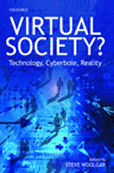 |
| About IR |
| Editors |
| Author instructions |
| Copyright |
| Author index |
| Subject index |
| Search |
| Reviews |
| Register |
| Home |
Woolgar, Steve (ed.) Virtual society? Technology, cyberbole, reality. Oxford: Oxford University Press, 2002. xviii, 349 p. ISBN 0-19-924876-1. £17.99.
Quite recently I reviewed a book by Johan Fornäs and others, Digital borderlands: cultural studies of identity and interactivity on the Internet . The book was based on a research project primarily financed by HSFR (the Swedish Council for Research in the Humanities and Social Sciences). The research team consisted of Professor Johan Fornäs and doctoral candidates from several research institutions in Sweden. The project included four sub-projects looking into rather different aspects of network communication.
Today I have on my desk another book based on the results of a huge research programme carried out in 25 UK universities and bringing together 76 researchers working on 22 projects. The programme was financed by the British Economic and Social Research Council.
The fact that almost at the same time two major national funding agencies financed the extensive and expensive research in social effects of ICTs is interesting in itself. One can guess that it signifies several developments: the concern about the social impact of new technologies by governmental agencies (fuelled by mass media, businesses, and other stakeholders), as well as the success of social science communities to demonstrate the value of the results of their work in the field. In both cases, Swedish and British, the researchers come up with 'counter-intuitive findings' (Woolgar, p. 21) that they brilliantly present in a well thought out publications. The British programme, however, is conducted on a much larger scale and involve the representatives of a wider range of disciplines.
The "Virtual Society?" volume contains 17 articles based on exciting body of research conducted by British scholars, except one contribution from the USA (Pollner, p. 230). The articles cover the following issues: ICTs use in various contexts, economic and political aspects, attitudes towards surveillance, role of ICT in education, concept of "virtuality", particularities of organisational adoption of ICT... But never mind the boring listing of topics - the articles provide interesting findings that dissolve the dominating prejudice and uncritical speculations about media, networks, information society, internet, and such. Each and every chapter is a sound empirical study offering deep analysis of the results. They reflect the impact of ICTs on society, and also the impact of social environment on the ICTs development and application. The most astonishing results reveal mutual influences among people's behaviour shaping the use of ICTs and ICTs changing human behaviour within a recognisable social environment. Besides evident scholarly value, it is also an exciting reading.
The volume is structured around the five rules of virtuality formulated by Woolgar on the basis of the research results (p. 14-20). I cannot resist the temptation to present them here:
- The uptake and use of the technologies depend crucially on local social context.
- The fears and risks associated with new technologies are unevenly socially distributed.
- Virtual technologies supplement rather than substitute for real activities.
- The more virtual the more real.
- The more global the more local.
I shall leave for the readers to find out what these rules mean in the context of the reviewed publication and how they are supported by the research findings. But I would like to draw the attention of the researchers in the areas of information behaviour, information management, IS design and other related fields to this book. It might serve as a useful aid for some existing research directions as well as a source of new ideas.
Elena Macevičiūtė
Högskolan i Borås
Sweden
September, 2003
How to cite this review
Macevičiūtė, E. (2003) Review of: Woolgar, Steve (ed.) Virtual society? Technology, cyberbole, reality. Oxford: Oxford University Press, 2002. Information Research, 9(1), review no. R112 [Available at: http://informationr.net/ir/reviews/revs112.html]